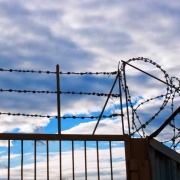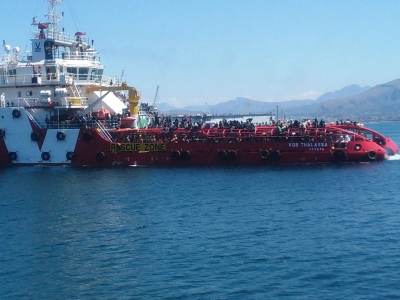Contrada Pian del Lago in Caltanissetta: camps in 2015
Measurements of eviction and fences are not enough to solve the problem of
hundreds of asylum seekers forced to wait up to four weeks before they can apply
for international protection. After the removal of spontaneously made up camps last year, hundreds of asylum
seekers who arrived in the city have for months stayed in houses provided by
speculators, paying up to 100 euro just for a mattress on the floor. These alternative accommodations to the camps have given less visibility to
this phenomena but the problem of asylum seekers, being forced to wait to be
identified in order to receive accommodation has never been solved.
Photo by Giovanna Vaccaro
The procedure of the police headquarters in
Caltanissetta to create an informal list with the names of those seeking asylum
continues and to scroll through the list during the three days weekly public
opening of the immigration office, calling for identification and for insertion
of being hosted.
What is unusual with this procedure of having an “informal list”?
First, the fact that the acceptance of the application for asylum does not
occur by its submission. Second, that the identification takes up to two weeks and
then passes additional time between the identification and the reception.
The most serious consequence that results from this practice is that during the
time between identification and formalization of the application for
international protection, which is done by filling in model ‘’C3’’, only when
reception is ready, these asylum seekers are not considered as such and
protected by any rights. This means that if they get into a police control,
they could be identified as irregular migrants, and, as such, end up in the CIE*
(if not yet identified) or directly receive a deportation order.
Another consequence of this practice is that,
throughout the period of waiting, these people are forced to live in makeshift
places: those who can afford it have a mattress in a home shared with several
roommates at the modest sum of 100 € a month while others have to camp outside,
in the area around the reception center and the Immigration office. The
makeshift camps of asylum seekers, who have been recently reformed in the same
places of the past, are two, while another group of people would live in an
abandoned house.
The total number of asylum seekers who find themselves in this situation is
therefore about a hundred.
Thirty men of Bangladeshi nationality, average aged 30, live in a basement of
the city’s sports center that had been vacated in March 2014.
Obviously there is no clean water, no
electricity and the cold and rain of recent weeks have made their already
difficult stay in this place even worse.
For food, they are telling me, they are buying things day by day in the nearest
stores. It’s mainly cold food since they are unable to cook, and since there’s
not even a canteen in the city. For dinner we brought them some food from
acquaintances that live in the CARA*.
We discussed the process of how long it takes to
gain access to the procedure for requesting asylum and reception. They inform me
that within 20 days you can be identified and receive reception. When they are
called for reception, they fill in the C3 form and finally formalize the
request for asylum.
After that, I go to a place where there is
another gathering of people, a place that extends below an overpass. In consists
of several tents, inside were scattered old mattresses which they had found and
collect from the local area. The cover of the overpass gives the impression of being
procted from th rain. In recent weeks there have been several storms and a large
swamp built up and makes living these conditions even more complicated.
From what I am hearing from the people I am
talking to, over here there are 60 people, all of Pakistani origin. They are as
well amongst the people waiting for identification, those waiting for reception,
those awaiting renewal of the residence permit.
When I asked how they are coping in these conditions they tell me I could see
by myself that there was “No water, no electricity, and no food.” They
manage to eat once a day and only thanks to some of their acquaintances who are
in the CARA*, and who in the evening bring their left over meals.
I ask to take pictures of the camp and I am granted permission. Then a guy comes
holding wood, they tell me to take a picture of him: that wood is heating for
the night.
‘Is it already so cold at night?’ – ‘Oh yes, very!’
Photo by Giovanna Vaccaro
I wonder if they’re all right, if there are
people with major health problems. They say that at the moment there is nothing
serious, just a few are slightly affected.
Then they remember the emergency number to call an ambulance. They already know
the service because, as they tell me, a few weeks ago, they had to help their
friend who had excruciating pain; they had to call five times before the
ambulance finally arrived.
Giovanna Vaccaro
Borderline Sicilia
*CIE – Centro di Identificazione ed
Espulsione: Identification and expulsion centre
*CARA – Centro
Accoglienza per Rifugiati e Richiedenti Asilo: Reception
centre for refugees and asylum seekers
Translator: Catherine Scholz






